Synchroslice – Multiple Slice Evaluation System
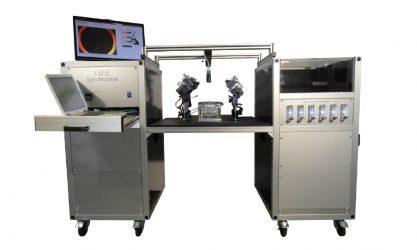 General
General
Acute vital tissue sections like the hippocampal slice preparation have become a valuable tool in neuropharmacology and toxicology for evaluation of drug effects in the pharmaceutical industry. However, with a single standard experimental setup only a few tissue slices can be characterized within one day. A higher throughput of tissue sections, different drugs or concentrations is difficult and time consuming.
With the new SYNCHROSLICE system Lohmann Research Equipment overcomes this problem by electrophysiological evaluation in up to 8 tissue slices simultaneously. Single dose-response curves can be examined with a single loading of 8 slices in an interface or submerged chamber. Sections can be electrically stimulated and extracellular somatic and dendritic field potentials are recorded simulatenously with eight 2-fold microelectrodes. Various stimulation protocols like single pulse, double pulse, HFS, LFS or theta stimulation (for LTP/LTD experiments) are possible.
Electrode positions are visualized with a color GigE camera system. Drugs are applied via a 8-fold valve system including a multichannel peristaltic pump.
The SYNCHROSLICE software controls the complete experiment including stimulation, drug application, data acquisition and on-and offline analysis. Signal parameters like peak amplitudes, slopes, latencies, area under curves, etc. are determined online and displayed during the experiment. Routine viability checks guarantee a continous control of tissue healthyness. Cutoff criteria can be set by the customer to stop recordings from non viable slices.
All parameters, settings, experimental and tissue identifications or acquired data are stored on HD. Export functions allow a transfer of data into conventional spreadsheet and analysis programs.
The SYNCHROSLICE drug effect explorer was originally designed for the classical hippocampal slice preparation. However, other tissue slices from neocortex or other structures in the brain and even acute heart slices can be evaluated.
Features
A complete 4-channel SYNCHROSLICE system (8-channel version also available) consists of:
- SynchroSlice Software package for programmable stimulation protocols (SynchroBrain/SynchroHeart)
incl. experimental control of perfusion and valve system. - 4-channel tissue slice chamber, each with either submerged or interface mode inner wells.
Wells manufactured from Teflon. With temperature sensor and heating pad. Chambers equipped with
all necessary tubing and cables. - 1 x Temperature controller type LRE LTR-3 for use with LRE slice chambers.
- 8-channel peristaltic pump digitally controlled via software.
- 4 x 2-channel valve system with chemically inert Teflon valves for switching between control and test
solutions - 6 x gas flow meters
- 1 x GigE inspection cameras (color) for use with TFT Video Monitor
- 1 x TFT Video monitor
- Movable camera system: 1 x XYZ manipulators for moving cameras up to 10mm in xy-direction and
20mm in z-direction. - Base plate with mounts and stands for micromanipulators (Standard-Duty Passive Isolation Mount)
- 8 x Marzhauser micromanipulator (MM33). Each equipped with electrode holding bar.
- 4 x 2-channel headstages type MCS MPA-2. Input resistance > 1 GOhm.
- Filter amplifier with fixed bandwidth of 1 Hz to 3 kHz.
- Online stimulator – controlled via Synchroslice software. Equipped with stimulus-isolation units.
- USB data acquisition system.
- 4 x single electrodes and 4 bipolar stimulation electrodes.
- Desktop PC / Laptop – Software preinstalled
- Complete system mounted in laboratory cabinet. Size approximately 220cm x 75cm x 160cm (w x d x h).
Any questions? Need a quote? Please let us know
Hardware
Manipulators
Because of our installed base plate it is easy to integrate nearly all kind of manipulators. Beside the most popular model MM33 there are many different types available. Also motorized manipulators pose no problem at all. Just let us know your preferences.
Electrodes
For high precision measurement also high precision electrodes are essential. We deliver electrodes optimized for your Synchroslice setup. Reusable over months and the lengths of tip and shaft will be adapted without additional costs. Quartz glass insulated platinum/tungsten fibre electrode (manufactured by Thomas RECORDING), Iridium-Oxide tip coating offers large charge transfer with small electrode tips, Low electrode/tissue impedance and high precision
Stimulation Electrodes
Monopolar:
- Impedance: < 100kOhm
- Customized connection; please specify with order (e.g.: connector for Synchroslice preamplifier,…)
- Customized electrode length; please specify with order L1 ( shaft length) and L2 (tip length)
- Electrode fibre strengthened with stainless steel cannula
- Outer diameter cannula: 254µm
Bipolar:
- Impedance: < 100kOhm
- Customized connection; please specify with order (e.g.: connector for Synchroslice preamplifier,…)
- Customized electrode length; please specify with order L1 (shaft length) and L2 (tip length)
- Electrode fibre strengthened with stainless steel cannula
- Outer diameter cannula: 254µm
Recording Electrodes
- Very good signal to noise (S/N-) ratio
- Impedance: appr. 0,5 MΩ
- Customized connection; please specify with order (e.g.: connector for Synchroslice preamplifier,…)
- Customized electrode length; please specify with order L1 ( shaft length) and L2 (tip length)
- Smooth passage between core conductor and insulator minimizes tissue damage
- High recording bandwidth (field potential and spike recordings)
- Microgrooves in the metal cause a large effective metal surface area, no platinization required
- High biocompatibility
- Well suited for microstimulation and Lesioning
Multiple Slice Chambers
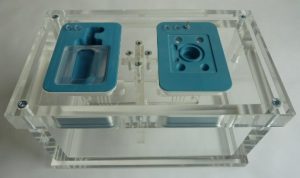
2 channel chamber
Since the original work of Yamamoto & McIlwain (1966) on thin sections from mammalian brain, the tissue slice technique has become the most frequently used in vitro method in neuroscience research. Today, different electrophysiological recording methods find application in slices from many different excitable tissues, not only from the brain, but also from other structures (e.g. heart, kidney, etc).
The new LRE multiple tissue slice chambers are a result of our 20 year lab experiences in slice technology. The main design benefits are a simple handling, flexibility and a precise temperature control. The chambers guarantee a high stability and a vital environment for tissue slices in electrophysiological, pharmacological and biochemical studies.
The outer chambers are manufactured from Acrylic glass. Inner recordings wells are made from either Acrylic glass or chemically inert PTFE in order to avoid adhesion problems of drugs in pharmacological studies (“sticky compounds”). Modular designed chambers with 1, 2, 3 or 4 inner recording wells are available as submerged or interface type chambers. Due to their precision, LRE tissue slice chambers are used in many applications including the drug screening system “Synchroslice”.
General features
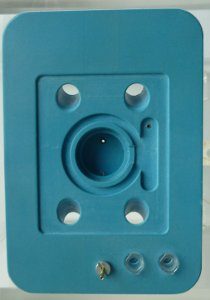
Submerged inlet
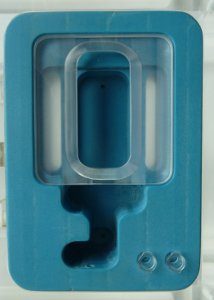
Interface Inlet
- Electrophysiological recordings from up to 4 slices simultaneously
- Exchangeable and combinable submerged or interface type recording chambers
- One outer bath; 1, 2, 3 or 4 recording wells of optional type
- Even customer-specific designs for inner recording chambers possible
- Precise temperature control (stability 0.1°C)
- Exchangeable PTFE (Teflon) type tubings
- Recording chambers available in different material, including chemically PTFE
- Easy cleaning of all parts possible
- Build in Ag/AgCl reference electrodes
- Base stands with flexible holders and fixations available, compatible with many commercial micromanipulators available
Our chambers allow individual setup of your experiments.
Combine different chamber inlets e.g. submerged and interface simultaneously or just use up to 4 channels with the same inlet type in one temperature controlled chamber. Even economically priced custom made inlets are available.
Software
SynchroBrain
Main Labbook
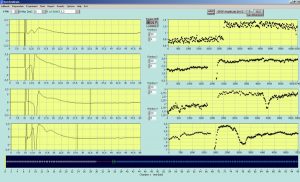
One of the basic concepts of the SynchroBrain program is its simple use.
The program can be handled without any knowledge of the exact program structure or mathematical procedures and is ideal for the routine work in the pharmacological and neurophysiologic lab. The screen of the SynchroBrain main menu is divided into different parts:
On the left side the field potentials from the recording electrodes in up to 4 slices are shown during the experiment, on the right side the detected peaks, latencies or other parameters are shown.
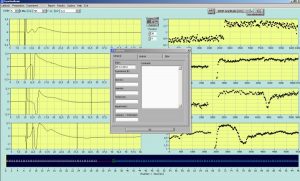
SYNCHROBRAIN gives the opportunity to document all settings of the experiment – important factors about the animal and the slice can be set and saved together with the experimental data.
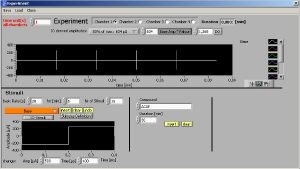
Preparation
To check all necessary parameters before starting an experiment SYNCHROBRAIN allows to test the function of the valve system and the peristaltic pump, set the detection criteria and test the responses for every single slice.
The viability of the slices is checked with the Input-Output relationship on up to 4 slices simultaneously and gives characteristic stimulus parameters for each slice. In case of working with a second stimulation-electrode per slice, it is possible to run the IO-curve separately for each electrode. Slices can be easily exchanged if the quality does not reach the customer defined criteria. When using the optional “Programmable Drug Application System” – PDAS – the parameters can also be set.
Experiment
Generate the time schedule for the automated experiment.SYNCHROBRAIN allows to set the duration of all the periods of stimuli and superfusion in a flexible and easy way for up to 2 stimulation electrodes and 4 slices in the same screen with a directly displayed time schedule. This way it is possible to perform independent experiments in different slices – e.g. a standard drug application protocol in one slice, performing an LTP experiment in a second slice and a I/O curve stimulation in a third and forth slice.
Optional the programmable drug application system (PDAS) is possible to use, which mixes automatically the compound in the ringer main stream. All settings can be saved. So it is possible to load them for the other chambers or in other experiments, what is very comfortable because of economy of time. Then the program automatically acquires data, displays the online results and stores all original data together with the experimental parameters into a file on the hard disc.
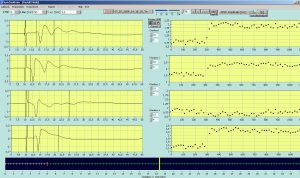
Analysis
Analysis parameters are selected from a predefined list and can be set as parameter for the online analysis and will be shown during the experiment together with the triggered responses.SYNCHROBRAIN enables an easy switching between these parameters in the online display to compare effects of drugs on different signal components. Offline all analysis tools can be repeated for comparison of different analysis strategies.
SynchroHeart
The SynchroHeart software is similar to the SynchroBrain software and works with the same Synchroslice platform but with special analysis parameters. It offers Labbook, Preparation, Experiment and analysis.
SynchroVolt
The SynchroVolt software is similar to the SynchroBrain software and works with the same Synchroslice platform and offers cyclic voltammetry and chronoamperometric measurements in 4 tissue slices simultaneously. Using the SynchroVolt software allows fully control over the experiment including electrical stimulation, compound application, online
data analysis and data documentation. It offers Labbook, Preparation, Experiment and analysis.
Addons
Double Stimulation
If you are using the Synchroslice with the two stimulation electrode option, you have the possibility to apply pulse protocols via 2 stimulation electrodes for each slice. The protocols of the 2 stimulation electrodes per slice need not to be the same. This feature is in particular important for LTP studies were different input connections to the target neurons should be compared (input specificity of LTP). The two schedules are displayed in the upper part. The schedule for electrode 1 is shown in the upper, the schedule for the second electrode in the lower part of the display.
PDAS
Drugs are added to a main stream (e.g. ACSF supported by a peristaltic pump) by use of a precision syringe pump. The end concentration of the applied compounds is only dependent on the flow rate of the main stream and the velocity of the syringe pump. Thus, different drug concentrations can be achieved only by changing the syringe pump velocity.
Only one stock solution of the compound is sufficient, no time consuming preparation of solutions are required.
Flow Control
To ensure a permanent constant flow we recommend our additional flow meter package for continuous observation and documentation of the experimental flow rate.
- Maximum Flow Rate: 5000 µl/min
- Digital Resolution at LCF (16 bit): 150 nl/min
- Temperature Coefficient: 0.1 (% m.v.b) / K
- Flow Detection Response Time t63: 40 ms
- Operating Temperature: +10…+50 +10…+50 °C
Any questions? Need a quote? Please let us know